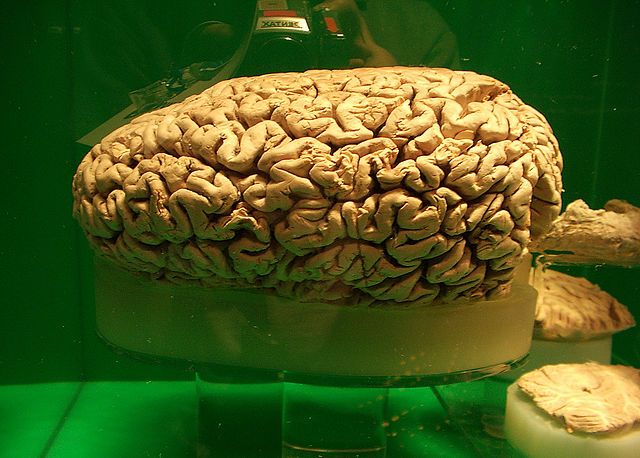
The main functions of the brainstem include:
- the transmission of information between the brain and the body;
- the supply of some of the cranial nerves to the face and head;
- and perform critical functions in the control of the heart, breathing, and consciousness.
- These functions are found in both the animal brain and the human brain.

If we talk about the size we can clarify that the brains of whales vary in size. Brain size tends to vary according to body size. The brain of the sperm whale is the largest, five times heavier than a human’s. The adult sperm whale brain is 8,000 cubic centimeters weighing about 8 kg (18 lb), while ours is about 1300 cubic centimeters. A human brain can weigh 1.5 kg in adulthood.
More for Sperm Whale brain
Although larger brains generally correlate with higher intelligence, it is not the only factor. In the case of the sperm whale, it has a lower encephalization ratio than many other species of whales and dolphins, lower than that of anthropoid monkeys.
The sperm whale’s brain is the largest of all mammals, both in absolute and relative terms. The olfactory system is reduced, which suggests that the sperm whale has a bad sense of taste and smell. On the contrary, the auditory system enlarges.
Rather than basing intelligence on brain size alone, some researchers believe that a better correlate of intelligence or cognitive skill should be based on the size of specific parts of the brain and how they compare to the rest of the brain and overall body size.
Killer Whale brain
Killer whales, also called killer whales, have the second heaviest brain among marine mammals. They are often described as intelligent, although defining and measuring “intelligence” is difficult in those whose environment and behavioral strategies are very different from those of humans. They can be trained in captivity.
People who have interacted closely with killer whales offer numerous anecdotes that demonstrate curiosity, play, and the ability to solve problems.
In Alaska, they learned how to steal fish from longlines. The fishermen have invented many methods to avoid it. One of these was fishermen whose boats several miles apart, taking turns to retrieve small amounts of their catch, in the hope that the whales would not have enough time to move between boats to steal the catch as it was being retrieved.
At first, it worked. Then the whales split into two groups. It did not even take them an hour to figure it out. They were so thrilled when they figured out what was going on, that we were playing games. They were breaching by the boats.
In other anecdotes, researchers describe incidents in which wild killer whales make fun of humans by repeatedly moving the objects that humans try to reach or suddenly start throwing a piece of ice when a human throws to snowball.
Blue Whale brain size
Although the blue whale is the largest cetacean, the same does not happen with its brain. The tallest Blue Whale verified by scientists was 98 feet (29.9 meters) tall.
The more cognitive capacity the greater the number of neurons. But that does not depend on the size of the brain.
A real case is the Blue Whales. They have proportionally small brains, only about 6.92 kilograms (15.26 lb), about 0.007% of their body weight, although with a highly convoluted cerebral cortex.
Humpback whale brain
Another case of great cognitive ability is the Humpback whale brain.
American researchers have discovered that the humpback whale has a type of brain cell that can only be found in humans, great apes and other cetaceans, such as dolphins.
This cell is known as the ‘spindle’ neuron in the cerebral cortex, in areas similar to those seen in humans and great apes.
Although the function of these neurons is not completely understood, they may be involved in cognitive processes, such as learning, remembering and recognizing the world around you.
The findings may also help explain some of the distinctive behaviors of whales, such as their sophisticated communication skills, the ability to form alliances and cooperate, the researchers said in remarks by The Times.
After the study, they believe that these are smarter than previously thought.
Despite the relative scarcity of information about many species of cetaceans, it is important to say that in this context that sperm whales, killer whales, and humpback whales exhibit complex social patterns that include intricate communication, coalition, and training skills, cooperation, cultural transmission and use of tools, the researchers wrote.
Beluga Whale brain
There are some anecdotes told about belugas that were taken into captivity. These anecdotes give us the idea of ‚Äč‚Äčthe brain capacity of a beluga whale.T
For example, in 2013, the Crimean Koktebel dolphinarium received a beluga whale that it would find that it could not communicate with any of its new companions. All bottlenose dolphins. But, although the situation was somewhat uncomfortable at the beginning. This whale that was well socialized with its congeners in its previous home, learned and adopted the language of the dolphins with which it shares space.
The beluga, who when she changed her house was four years old, began to make whistles typical of dolphins after a short time of coexistence. Unfortunately, this means that she stopped emitting gradually the sounds of her kind. Particularly interesting is that it reproduced characteristic whistles of each dolphin, like the names. It’s as if the whale started talking about the dolphin.
Beluga able to imitate the human voice
Another particular case is that of NOC, the male beluga that has managed to imitate human language with complex sounds that induce us to think that it is trying to communicate with us.
In 1984 scientists from the National Marine Mammal Foundation in San Diego, began to investigate the unusual noises emitted by belugas and dolphins over long distances for their communication. The recordings were similar to those of two people talking at a distance. But in a range of frequencies different from those of the human, without the researchers being able to understand the sounds.
The scholars speculate with the hypothesis of the mimicry of human sound, the truth is that the argument of imitation is not convincing, but rather the ability to try to communicate spontaneously with human beings.
Beluga moves to the rhythm of the music
A charming piece of anecdotal evidence provides an additional clue to the cognitive abilities of a beluga whale.
A third report is that of a beluga whale that moved its head towards the music played outside its tank. According to neurobiologist Aniruddh Patel, dance, or the ability to perceive rhythms and synchronize body movements with what is heard. Itis the product of a complex set of processes. One that, until recently, was among the distinctive hallmarks of the exclusively human skills.
The act of dancing at a rhythm is surprisingly complex: it requires creating and responding to a model inside the head in relation to what is heard externally. Indicates the ability to predict and wait. It also indicates that belugas could be vocal learners, just like people. another indication of cognitive complexity.
There is still much we can learn from these whales. And these reports indicate the great cognitive capacity of their brains.
The power of the whale’s brain
In the world of whales as in other cetaceans, intelligence can be observed in many ways.
Learning
Research made in recent years have revealed that whales not only have the capacity to learn as individuals. But that these individuals can transmit new knowledge to others. This is a form of intelligence that is not usual to observe in the animal kingdom.
Game
Recently, a video of incredible games between Bottlenose Dolphins and Humpback Whales has been revealed in the waters of Hawaii. The dolphins swam to the face of the whale, which rises above the water at high altitude so that the dolphin slides down in a big dip. As the game is repeated over and over again, it seems clear that both animals enjoy it.
Feeding
Humpback whales use, for example, the bubble cage. Once a shoal is detected, a direct attack would involve dispersing the fish. Instead of attacking them, then, they swim underneath them in increasingly compact circles, releasing air bubbles in the meantime.
The bubbles, densely grouped in circles, ascend in a circular fashion, effectively catching the fish against the surface of the water and then, at the right moment. The whales swim to the surface, with their mouths open and swallow the fish in large quantities.
In some cases, this behavior develops individually while in others it can be a group. In this second case, whales can assume different roles. Some blow the bubbles, others dive deep to ensure that the fish rise, producing sounds to help the prey. Teamwork, transmitted from generation to generation.
Orcas in Norway, for example, work together to herd schools of herring. Swimming around and under their prey to concentrate the shoal against the surface creating a ‘whale’ of fish. Then some specimens that circle around hit her with their tails, stunning the fish to feed easily.
Rights of whales
We human beings consider ourselves intelligent beings and worthy of freedom. After analyzing the capacity of the brain of the whales and their intelligence, should not their rights also be recognized?
There is a growing movement that thinks so. In 2010, a manifesto entitled ‘Declaration of the Rights of Cetaceans: Whales and Dolphins’ was published and the first NGO to adopt the Declaration was WDCS. The document holds that all whales and dolphins have the right to life, liberty, and welfare.
You may also like…
Are there any of the classic movies that you do not have yet? Think about those family, adventure or killer whale movies that you would enjoy to watch again and again. Ofwhale.com shows you a selection of those movies.
Most people loves whales enjoy using CDs with the whale sounds , whale songs and sounds of the waves to obtain a peaceful and restful sleep, perform meditation and relaxation.
Ofwhale.com is the right place where you can get the whale pictures you deserve for your home. Read more about the feelings you convey and the styles you can choose.
You want to go further than just follow the first step by step tutorials about whale drawings. Ofwhale.com is the place where you can find books and models you need to go deeper into the ocean and learn to draw your preferred whales and marine creatures.




